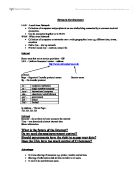* linear topology: See bus topology.
* mesh topology: A network topology in which there are at least two nodes with two or more paths between them.
* ring topology: A network topology in which every node has exactly two branches connected to it.
* star topology: A network topology in which peripheral nodes are connected to a central node, which rebroadcasts all transmissions received from any peripheral node to all peripheral nodes on the network, including the originating node. Note 1: All peripheral nodes may thus communicate with all others by transmitting to, and receiving from, the central node only. Note 2: The failure of a transmission line, i.e., channel, linking any peripheral node to the central node will result in the isolation of that peripheral node from all others. Note 3: If the star central node is passive, the originating node must be able to tolerate the reception of an echo of its own transmission, delayed by the two-way transmission time, i.e., to and from the central node, plus any delay generated in the central node. An active star network has an active central node that usually has the means to prevent echo-related problems. (188)
* tree topology: A network topology that, from a purely topologic viewpoint, resembles an interconnection of star networks in that individual peripheral nodes are required to transmit to and receive from one other node only, toward a central node, and are not required to act as repeaters or regenerators. (188) Note 1: The function of the central node may be distributed. Note 2: As in the conventional star network, individual nodes may thus still be isolated from the network by a single-point failure of a transmission path to the node. Note 3: A single-point failure of a transmission path within a distributed node will result in partitioning two or more stations from the rest of the network.
This HTML version of FS-1037C was last generated on Fri Aug 23 00:22:38 MDT 1996
More of this Feature
• Part 1: LAN, WAN, and Other Area Networks
Join the Discussion
"I wouldn't use coax, not popular... Only good for bus topology but that's in theory."
-DITCHDOGGY
Related Resources
• Network Design
In networking, the term topology refers to the layout of connected devices on a network. This article introduces the standard topologies of computer networking.
Topology in Network Design
One can think of a topology as a network's "shape." This shape does not necessarily correspond to the actual physical layout of the devices on the network. For example, the computers on a home LAN may be arranged in a circle, but it would be highly unlikely to find an actual ring topology there.
Network topologies are categorized into the following basic types:
* bus
* ring
* star
* tree
* mesh
More complex networks can be built as hybrids of two or more of the above basic topologies.
Bus network topology
Bus Topology
Bus
Bus networks (not to be confused with the system bus of a computer) use a common backbone to connect all devices. A single cable, the backbone functions as a shared communication medium, that devices attach or tap into with an interface connector. A device wanting to communicate with another device on the network sends a broadcast message onto the wire that all other devices see, but only the intended recipient actually accepts and processes the message.
Ethernet bus topologies are relatively easy to install and don't require much cabling compared to the alternatives. 10Base-2 ("ThinNet") and 10Base-5 ("ThickNet") both were popular Ethernet cabling options years ago. However, bus networks work best with a limited number of devices. If more than a few dozen computers are added to a bus, performance problems will likely result. In addition, if the backbone cable fails, the entire network effectively becomes unusable.
Ring network topology
Ring Topology
Ring
In a ring network, every device has exactly two neighbors for communication purposes. All messages travel through a ring in the same direction (effectively either "clockwise" or "counterclockwise"). A failure in any cable or device breaks the loop and can take down the entire network.
To implement a ring network, one typically uses FDDI, SONET, or Token Ring technology. Rings are found in some office buildings or school campuses.
Star
Many home networks use the star topology. A star network features a central connection point called a "hub" that may be an actual hub or a switch. Devices typically connect to the hub with Unshielded Twisted Pair (UTP) Ethernet.
Star network topology
Star Topology
Compared to the bus topology, a star network generally requires more cable, but a failure in any star network cable will only take down one computer's network access and not the entire LAN. (If the hub fails, however, the entire network also fails.)
Tree
Tree topologies integrate multiple star topologies together onto a bus. In its simplest form, only hub devices connect directly to the tree bus, and each hub functions as the "root" of a tree of devices. This bus/star hybrid approach supports future expandability of the network much better than a bus (limited in the number of devices due to the broadcast traffic it generates) or a star (limited by the number of hub ports) alone.
Mesh
Mesh topologies involve the concept of routes. Unlike each of the previous topologies, messages sent on a mesh network can take any of several possible paths from source to destination. (Recall that in a ring, although two cable paths exist, messages can only travel in one direction.) Some WANs, like the Internet, employ mesh routing.
Conclusion
Topologies remain an important part of network design theory. You can probably build a home or small business network without understanding the difference between a bus design and a star design, but understanding the concepts behind these gives you a deeper understanding of important elements like hubs, broadcasts, ports, and routes.







